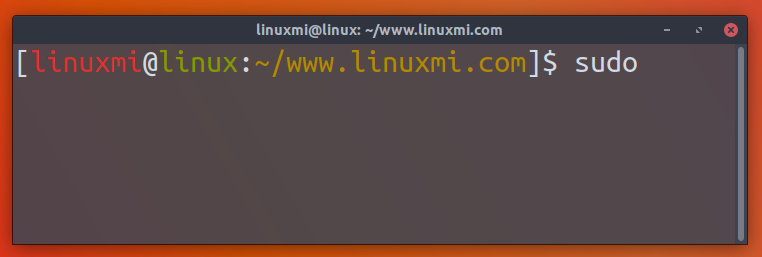sudo 与 su 两个命令的最大区别是:
sudo 命令需要输入当前用户的密码,su 命令需要输入 root 用户的密码。另外一个区别是其默认行为。sudo 命令只允许使用提升的权限运行单个命令,而 su 命令会启动一个新的 shell,同时允许使用 root 权限运行尽可能多的命令,直到明确退出登录。

su 用以切换成不同的用户的身份

默认只是切换身份,并没有切换环境变量,环境变量依然是普通用户的。切换用户身份时,用户的环境变量也切换成新用户的环境变量,所以"-"不能省略,不然有些操作无法执行。
su root 输入root密码后切换之root用户但是pwd目录不变

su - root 输入root密码后切换之root用户但是pwd目录/root

sudo 一般加的是命令
sudo -i root与sudo - root、sudo -i ,sudo - ,sudo root效果相同 提示输入密码时该密码为当前账户的密码 要求执行该命令的用户必须在sudoers中才可以 su需要的是切换后账户的密 用法为“su 账户名称”
sudo : 暂时切换到超级用户模式以执行超级用户权限,一般指的是root用户,提示输入密码时该密码为当前用户的密码,而不是超级账户的密码。不过有时间限制,Ubuntu默认为一次时长15分钟。
su :切换到某某用户模式,提示输入密码时该密码为切换后账户的密码,用法为“su 账户名称”。如果后面不加账户时系统默认为root账户,密码也为超级账户的密码。没有时间限制。
sudo -i: 为了频繁的执行某些只有超级用户才能执行的权限,而不用每次输入密码,可以使用该命令。提示输入密码时该密码为当前账户的密码。没有时间限制。执行该命令后提示符变为“#”而不是“$”。想退回普通账户时可以执行“exit”或“logout” 。要求执行该命令的用户必须在sudoers中才可以

sudo -i 直接运行sudo命令加-i参数 要求执行该命令的用户必须在sudoers中才可以

sudo su 运行sudo命令给su命令提权,运行su命令。要求执行该命令的用户必须在sudoers中才可以。
Linux命令——su 、su -、sudo
前言
大部分Linux发行版的默认账户是普通用户,而更改系统文件或者执行某些命令,需要root身份才能进行,这就需要从当前用户切换到root用户。
切换用户身份有两个命令 su [-] username 和 sudo
su和su -区别
su只是切换了root身份,但Shell环境仍然是普通用户的Shell;此时pwd,发现工作目录仍然是普通用户的工作目录
su -连用户和Shell环境一起切换成root身份了。只有切换了Shell环境才不会出现PATH环境变量错误。此时pwd,工作目录变成root的工作目录了。用echo $PATH命令看一下su和su -以后的环境变量有何不同。
bash-4.2$ echo $PATH
/usr/local/bin:/usr/bin:/usr/local/sbin:/usr/sbin
[root@localhost ~]# echo $PATH
/usr/local/sbin:/usr/local/bin:/sbin:/bin:/usr/sbin:/usr/bin:/root/bin
以此类推,要从当前用户切换到其它用户也一样,应该使用su -命令。
su和sudo的区别
su 或者 su -可以切换用户身份,而且每个用户都能切换到root用户,只要他知道root密码即可。这样很不安全,万一哪个用户不消息泄露了root密码就GG了。
于是引出了改进版命令sudo
使用sudo执行一个只有root才能执行的命令是可以办到的,但是需要密码。注意。这里的密码不在是root的密码,而是用户自己的密码。默认情况下只有root用户才能执行sudo命令,普通用户要想执行sudo,需要root预先设定。通过visudo命令编辑/etc/sudoers来实现。(好像直接vi /etc/sudoers也行)
/etc/sudoers文件内容如下
## Sudoers allows particular users to run various commands as
## the root user, without needing the root password.
##
## Examples are provided at the bottom of the file for collections
## of related commands, which can then be delegated out to particular
## users or groups.
##
## This file must be edited with the 'visudo' command.
## Host Aliases
## Groups of machines. You may prefer to use hostnames (perhaps using
## wildcards for entire domains) or IP addresses instead.
# Host_Alias FILESERVERS = fs1, fs2
# Host_Alias MAILSERVERS = smtp, smtp2
## User Aliases
## These aren't often necessary, as you can use regular groups
## (ie, from files, LDAP, NIS, etc) in this file - just use %groupname
## rather than USERALIAS
# User_Alias ADMINS = jsmith, mikem
## Command Aliases
## These are groups of related commands...
## Networking
# Cmnd_Alias NETWORKING = /sbin/route, /sbin/ifconfig, /bin/ping, /sbin/dhclient, /usr/bin/net, /sbin/iptables, /usr/bin/rfcomm, /usr/bin/wvdial, /sbin/iwconfig, /sbin/mii-tool
## Installation and management of software
# Cmnd_Alias SOFTWARE = /bin/rpm, /usr/bin/up2date, /usr/bin/yum
## Services
# Cmnd_Alias SERVICES = /sbin/service, /sbin/chkconfig, /usr/bin/systemctl start, /usr/bin/systemctl stop, /usr/bin/systemctl reload, /usr/bin/systemctl restart, /usr/bin/systemctl status, /usr/bin/systemctl enable, /usr/bin/systemctl disable
## Updating the locate database
# Cmnd_Alias LOCATE = /usr/bin/updatedb
## Storage
# Cmnd_Alias STORAGE = /sbin/fdisk, /sbin/sfdisk, /sbin/parted, /sbin/partprobe, /bin/mount, /bin/umount
## Delegating permissions
# Cmnd_Alias DELEGATING = /usr/sbin/visudo, /bin/chown, /bin/chmod, /bin/chgrp
## Processes
# Cmnd_Alias PROCESSES = /bin/nice, /bin/kill, /usr/bin/kill, /usr/bin/killall
## Drivers
# Cmnd_Alias DRIVERS = /sbin/modprobe
# Defaults specification
#
# Refuse to run if unable to disable echo on the tty.
#
Defaults !visiblepw
#
# Preserving HOME has security implications since many programs
# use it when searching for configuration files. Note that HOME
# is already set when the the env_reset option is enabled, so
# this option is only effective for configurations where either
# env_reset is disabled or HOME is present in the env_keep list.
#
Defaults always_set_home
Defaults env_reset
Defaults env_keep = "COLORS DISPLAY HOSTNAME HISTSIZE KDEDIR LS_COLORS"
Defaults env_keep += "MAIL PS1 PS2 QTDIR USERNAME LANG LC_ADDRESS LC_CTYPE"
Defaults env_keep += "LC_COLLATE LC_IDENTIFICATION LC_MEASUREMENT LC_MESSAGES"
Defaults env_keep += "LC_MONETARY LC_NAME LC_NUMERIC LC_PAPER LC_TELEPHONE"
Defaults env_keep += "LC_TIME LC_ALL LANGUAGE LINGUAS _XKB_CHARSET XAUTHORITY"
#
# Adding HOME to env_keep may enable a user to run unrestricted
# commands via sudo.
#
# Defaults env_keep += "HOME"
Defaults secure_path = /sbin:/bin:/usr/sbin:/usr/bin
## Next comes the main part: which users can run what software on
## which machines (the sudoers file can be shared between multiple
## systems).
## Syntax:
##
## user MACHINE=COMMANDS
##
## The COMMANDS section may have other options added to it.
##
## Allow root to run any commands anywhere
root ALL=(ALL) ALL
## Allows members of the 'sys' group to run networking, software,
## service management apps and more.
# %sys ALL = NETWORKING, SOFTWARE, SERVICES, STORAGE, DELEGATING, PROCESSES, LOCATE, DRIVERS
## Allows people in group wheel to run all commands
%wheel ALL=(ALL) ALL
## Same thing without a password
# %wheel ALL=(ALL) NOPASSWD: ALL
## Allows members of the users group to mount and unmount the
## cdrom as root
# %users ALL=/sbin/mount /mnt/cdrom, /sbin/umount /mnt/cdrom
## Allows members of the users group to shutdown this system
# %users localhost=/sbin/shutdown -h now
## Read drop-in files from /etc/sudoers.d (the # here does not mean a comment)
#includedir /etc/sudoers.d
重点介绍下面两处

①此处可以单独设置某个用户。3列分别代表 用户名 我也不知道(反正都这么写) 指定可以使用sudo的命令有哪些
②如果用户有几百几千个,总不能一条一条写吧。。。加入wheel组就可以实现所有用户都有sudo权力。